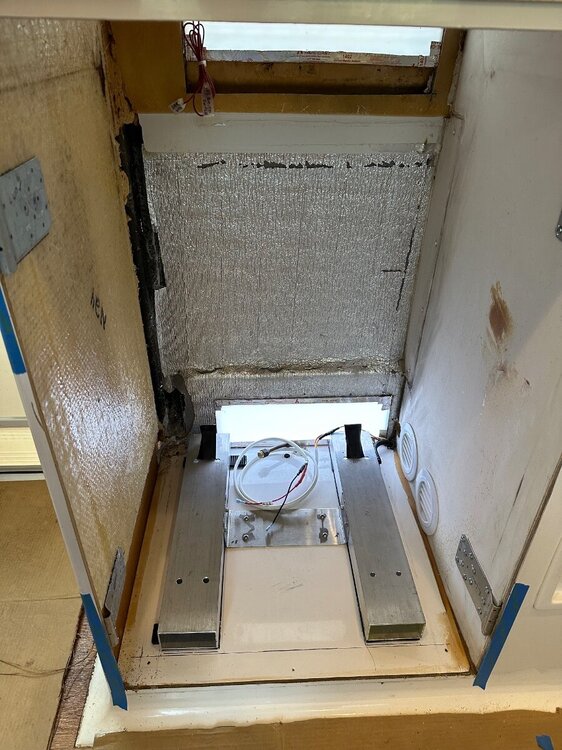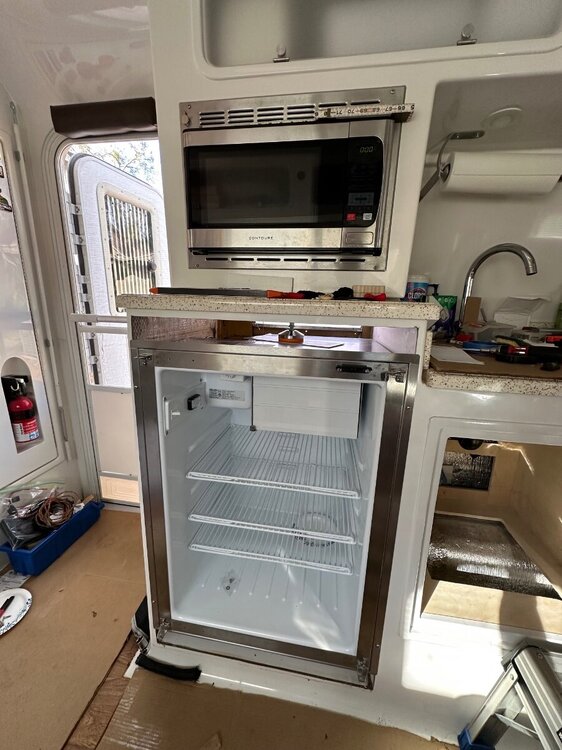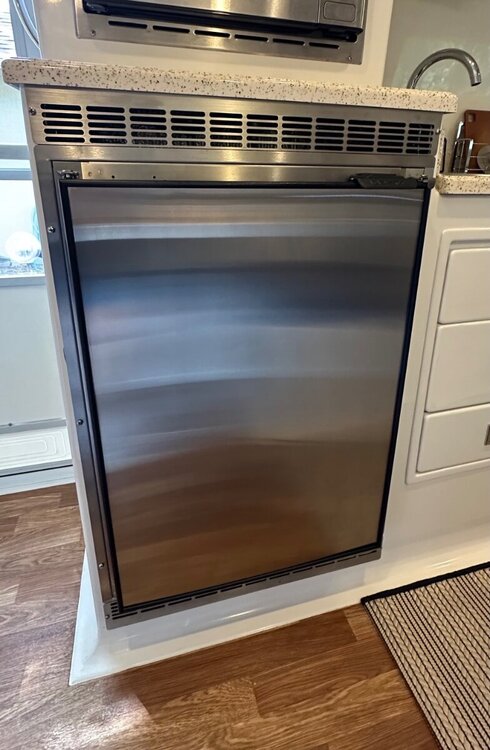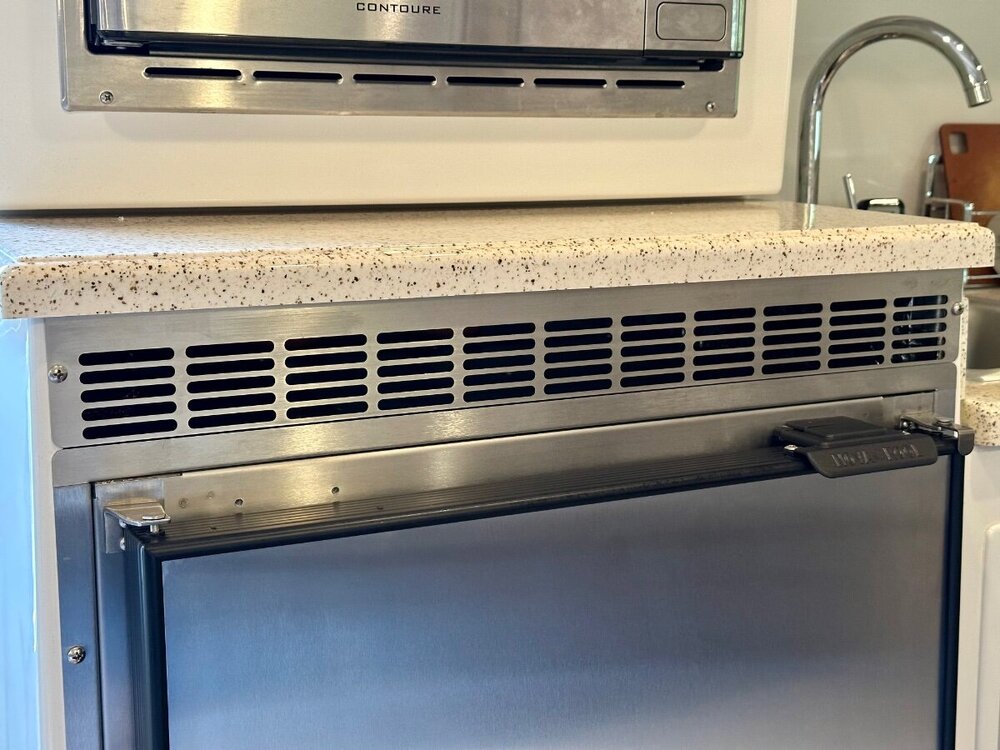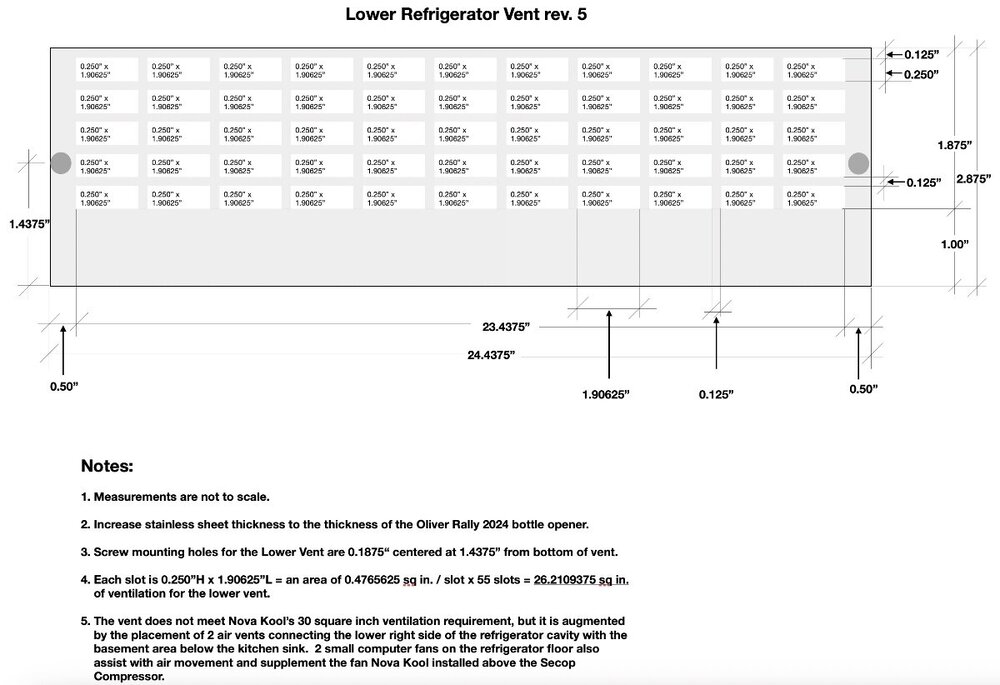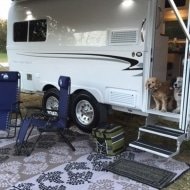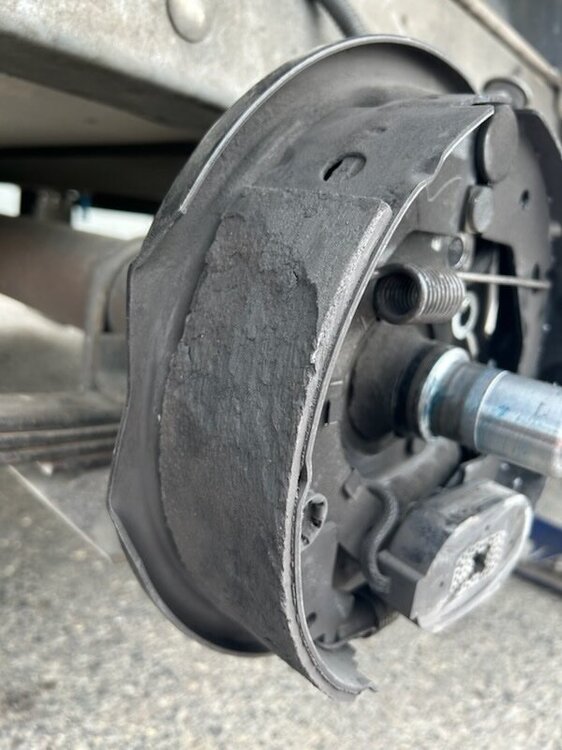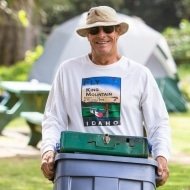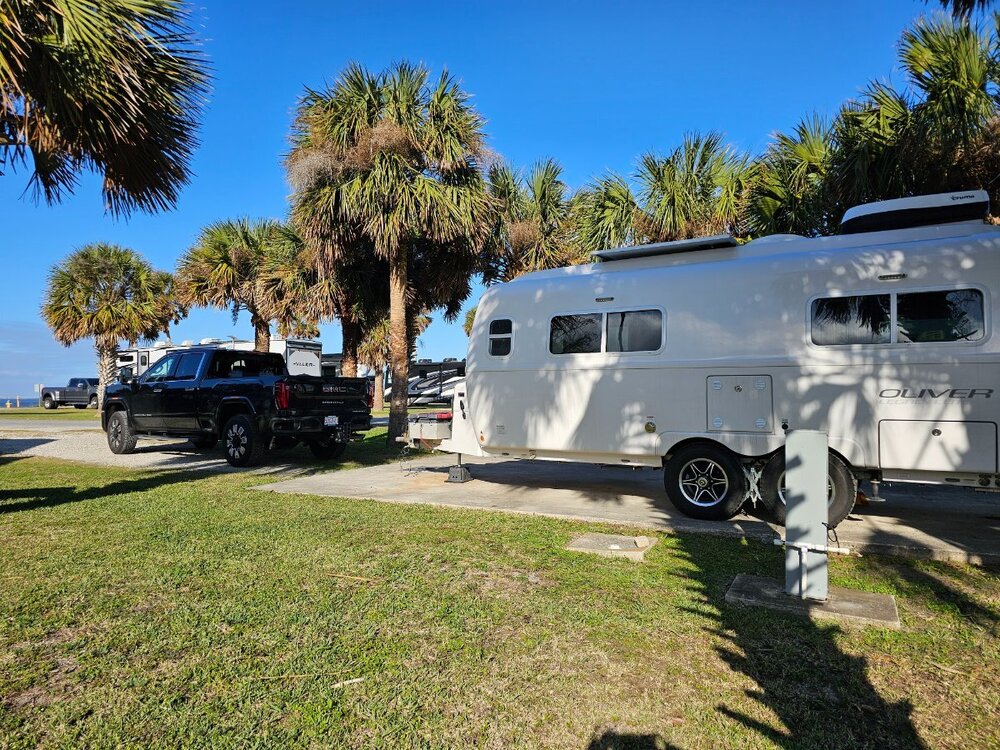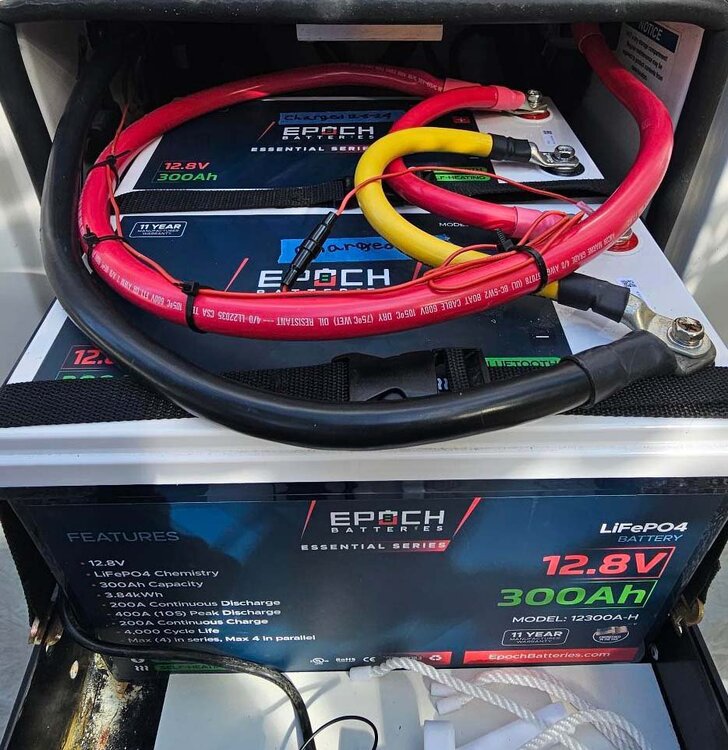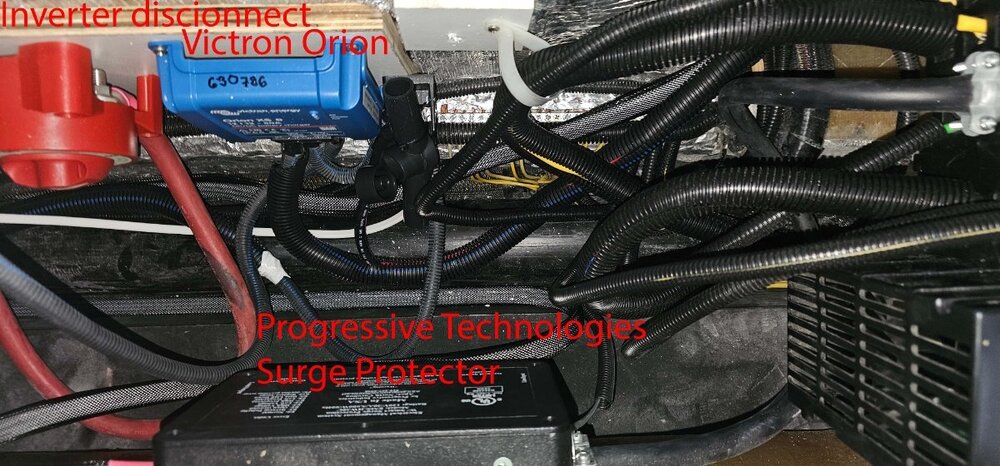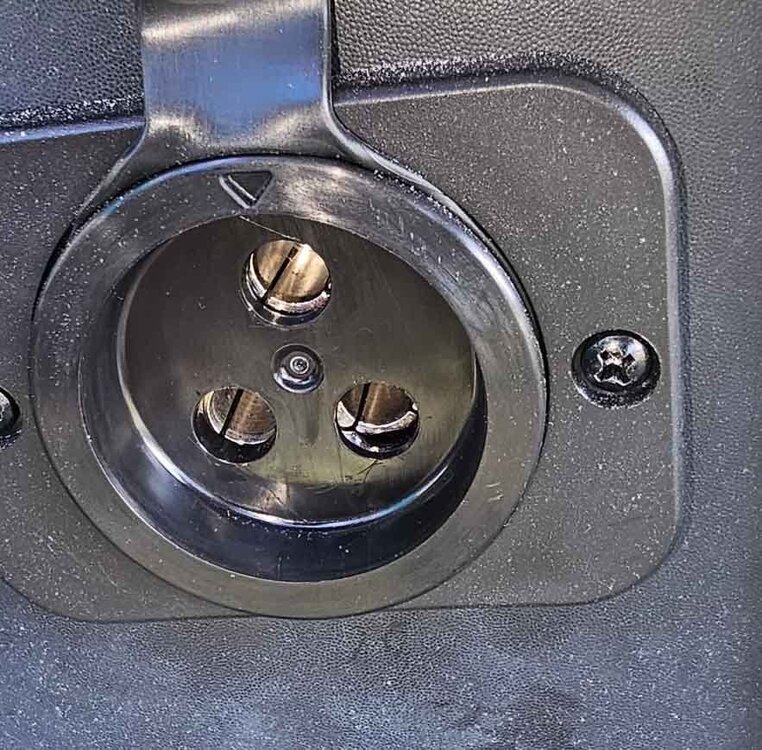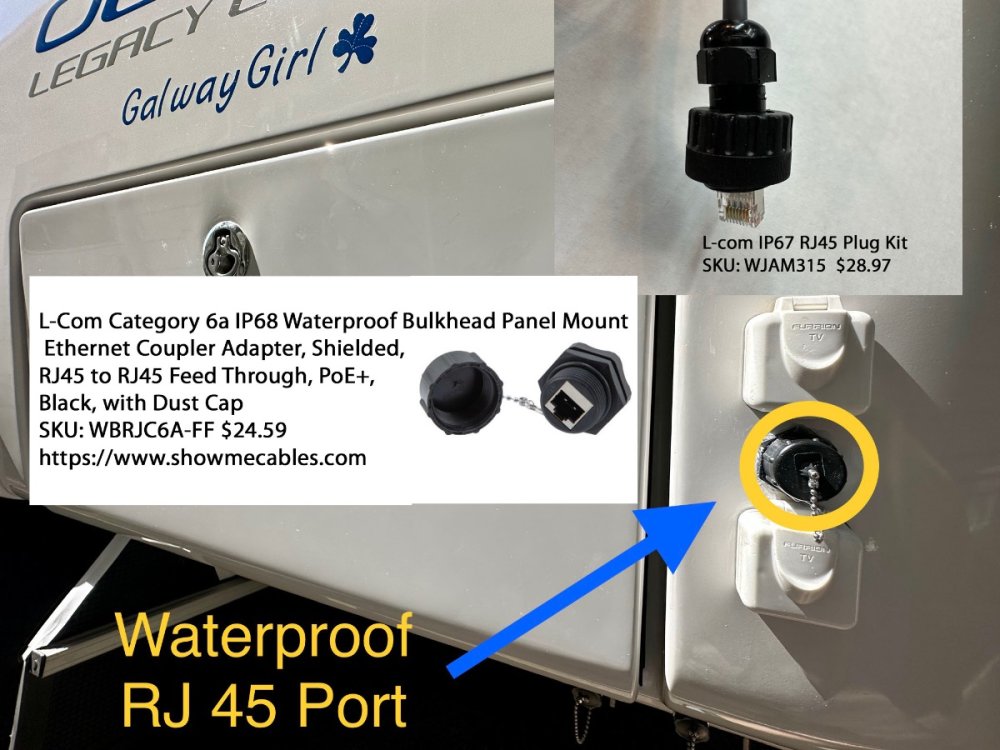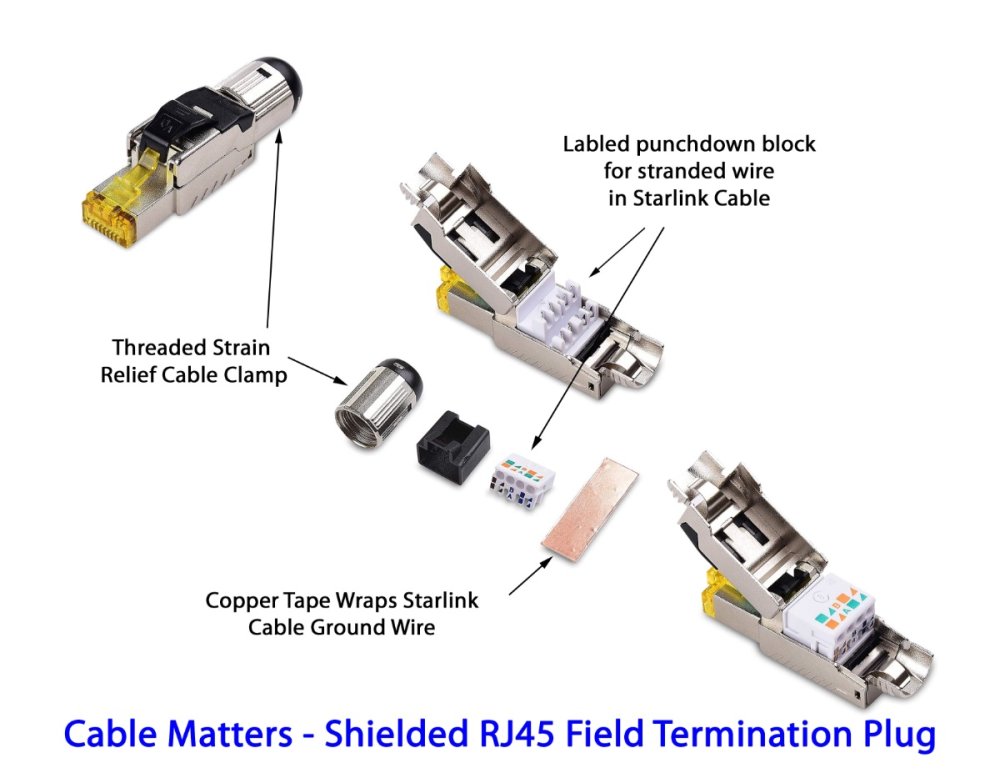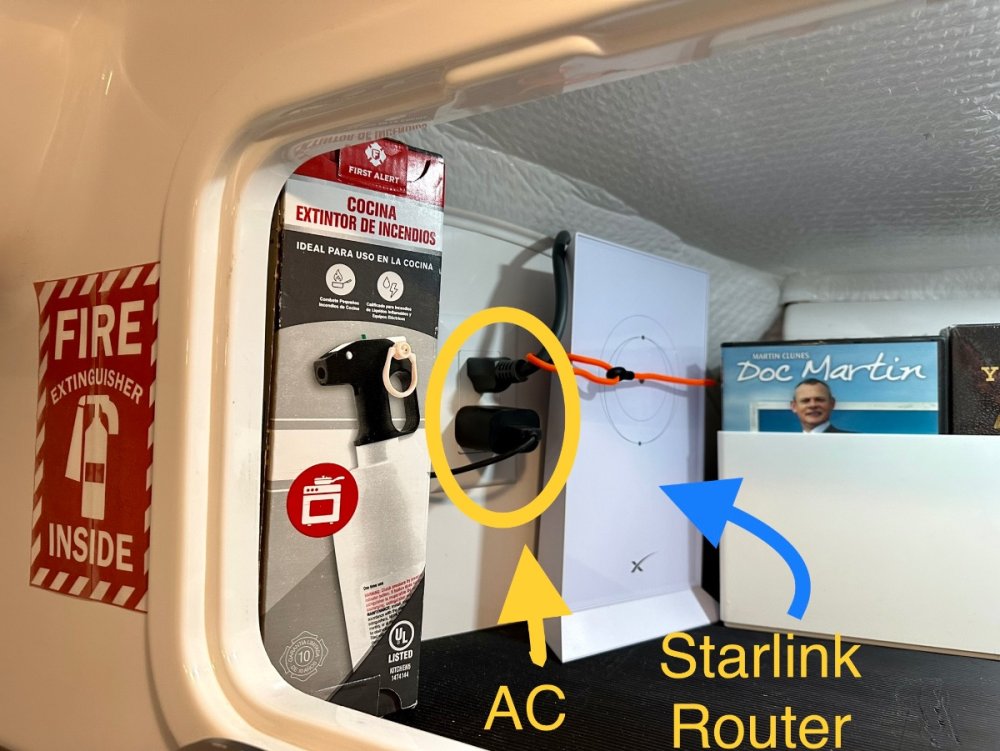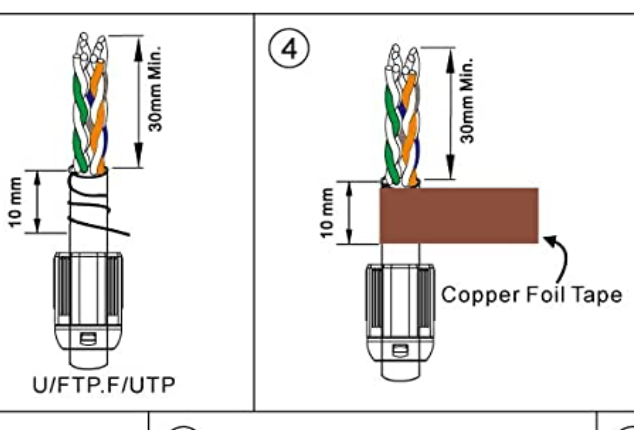Search the Community
Showing results for tags 'elite 2'.
-
On a recent trip from Dallas to South Carolina we stayed in multiple locations with no (or very limited) communications capabilities (cell phone or WiFi). Over the three years we have owned our LEII, there have been many other occasions with no ability to communicate. As a result, we decided to order a Starlink Mini and a Starlink Router Mini to use on our trailer trips. I have been following Starlink related postings on the OTT Owners Forum, especially since the release of the Starlink Mini. I have found the postings by @Snackchaser particularly helpful in planning the installation of our Starlink system. I especially liked the use of a Power over Ethernet (PoE) injector to power the Starlink Mini and to provide an Ethernet connection from the built-in router back to the trailer, using a single cable. Installing the PoE injector and a DC powered router in the attic of the LEII seemed a reasonable location, being nearly directly above the exterior Furrion ports for connecting satellite and cable TV. So I planned to install in a similar location in the attic of our LEII, assembling a list of the components required. I ordered a PoE injector from MobileMustHave.com and the rest from Amazon. Once all the key components had been delivered, I began the installation, with the first step being to replace the Furrion Satellite coax port with an RJ45 pass-through connector and to fish an Ethernet cable from the basement to the attic. Replacing the Furrion coax connector with the RJ45 pass-through connector was no problem, even though enlarging the hole through fiberglass exterior shell was required. However, fishing an Ethernet cable from the basement to the attic proved to be a major obstacle. Although I have prior experience fishing wires through difficult spaces, I was unsuccessful getting a fish tape (or rods) from the attic to the basement. I could get the end of the fish tape rods down near the ceiling of the basement, where the interior shell ends and multiple cables run up to the attic area at the rear of the trailer, but not into the basement. As suggested, I tried following the A/C drain line and multiple other locations but could not get past the bottom of the inner shell into the basement. I tried running the fish tape/rods in both directions. No luck. Consequently, I began to ponder other installation locations inside the trailer for the PoE injector and Starlink Router Mini. After a couple of days, I had an Aha! moment- install the PoE Injector and Router Mini under the rear dinette seat. I inspected the space between the basement and the rear dinette seat, nearly all of which is readily accessible from the two rear street side hatches and the rear dinette seat hatch. Only the space under the battery compartment is not accessible from directly above, but is easily accessed from either side. I looked for any obstacles to using this location and found none. I could easily route the Ethernet cable from the Furrion/RJ45 pass-through connector forward to beneath the rear dinette seat. I located the PoE Injector atop the trailer frame member, just below the Progressive surge protector box, which is mounted on the aisle wall of the rear dinette seat. The PoE jack and the power terminals of the PoE Injector are positioned toward the front of the trailer. I connected a 20 foot shielded Cat 6 cable from the inner side of the Furrion/ RJ45 port, then routed it under the floor of the basement, around the street side rear stabilizer, then following the waste water line, forward to the area under the rear dinette hatch. About 3 feet of excess cable are coiled in the basement, concealed by the rear wall of the basement. I installed a lighted rocker switch through the forward basement wall, mounted high, almost directly above the side-to-side bubble level on the left side of the basement entry. This switch is to control 12VDC power to the PoE Injector and the Starlink Router Mini. Using 14 AWG silicone coated wire, I ran two purple colored wires from the space beneath the rear dinette hatch back to the rocker switch on the forward basement wall. A third, 14 AWG black wire was also run along the same route to the rocker switch. The switch has two terminals with red lead wires,: one to the DC power source and one to the load. The third terminal has a black wire, which connects to ground (the bus bar). The ground wire enables the light on the switch to operate when DC power is ON. On the DC power panel, position 15, I installed a 15 amp fuse. One of the purple wires connects to the 12VDC positive terminal on the PoE Injector. The other purple wire connects to position 15 on the rear of the DC power panel, using a crimp on connector. The single black wire from the switch connects to the ground bus located under the rear dinette seat. Another 14 AWG wire connects the PoE Injector negative terminal with the other end connecting to the bus bar. All wire-to-wire connections were made using Wago lever lock connectors. I also added a 12VDC auxiliary power outlet (cigarette lighter type) which is connected to the same circuit as that which powers the PoE Injector. An Anker 323 USB-C Car Charger Adapter (USB Power Delivery (PD) capable) plugs into the auxiliary power outlet. A USB-C to Male to DC 3.5 x 1.35mm Male Power Jack is used to power the Starlink Router Mini from the Anker charger. I found the Starlink Router Mini conveniently fits on top of the Progressive Surge Protector box. I later secured it with a releasable zip tie around the surge protector. The 20 foot Cat 6 Ethernet cable from the rear connects to the PoE jack of the PoE Injector. A 5 foot Cat 6 Ethernet cable connects to the LAN jack of the PoE Injector and to the WAN/Satellite port of the Starlink Router Mini. All Cat 6 Ethernet cables used are shielded. I believe this installation location approach has several advantages over an attic installation: Access is MUCH easier. Fishing wires is no challenge. A dedicated circuit from the DC power panel provides power to all Starlink related components. A lighted switch for the PoE Injector and Starlink Router Mini is located in the basement, near the exterior pass-through Ethernet jack. The PoE Injector is located where it cannot be covered by clothing or other cargo stored in the attic which might cause overheating. The VERY bright blue light on the PoE Injector is not visible in the cabin (always ON if power to the PoE Injector is ON). The Starlink Router Mini is located centrally in the trailer and should provide uniform WiFi coverage within the trailer. We have not yet taken the Starlink on a shakedown trip, but plan to do so at the end of August. Regards, Don
-
Everytime I pull out my faucet to shower. I lose my water pressure. Is this normal? How can I fix this?
-
Haloview BT7 Touch Rear Camera installation on 2022 LEII
dhaig posted a topic in Ollie Modifications
I recently purchased a Haloview BT7 Touch Rear Camera to replace the Furrion Vision S Camera System (Model F0S43TADS) we purchased as an accessory option on our 2022 LEII. Following delivery of our trailer in February, 2022, it was quickly evident the Furrion camera was largely useless. I continued to use the Furrion camera, with increasing frustration. The very limited view to the rear was a safety issue. I began to research RV rear cameras and after reading many reviews selected the Haloview BT7 Touch. I was impressed by the specs and favorable reviews, but failed to note the camera is designed to mount to a vertical rear wall, not the sloping rear roof of an LEII. I could have returned the Haloview camera, but I did not see a good second choice. Thus, I decided to fabricate a mount to be installed in the same position as the Furrion camera. The result is the custom mount below: Fabrication Process I had some black acrylic sheet, .010" thick, from a prior project (See: Window Vent Mod- Louvered Ventilators), which seemed suitable material for a camera mount. I had some thicker acrylic sheet, but decided to first use the thinner sheet to create a mockup by bending the acrylic sheet. Initially, I had concerns the thinner sheet would not be sufficiently rigid to hold the camera steady, but I was not sure I could bend the thicker sheet. The Furrion camera and its mounting gasket were removed from the roof of our LEII and used to begin the layout of the base for the new mount. I wanted to use the four existing holes in the roof which held the Furrion camera in place. I had a scrap piece of acrylic about 7" wide and 20" long. I used 2" blue painter's tape applied to the acrylic and, with a fine point mechanical pencil, began marking out the mounting hole pattern from the Furrion gasket. Next, I flipped the scrap sheet of acrylic over, applied blue tape and began positioning the Haloview camera on the tape. My initial concept was to have the main part of the mount be a single piece of acrylic bent to an angle of approximately 80 degrees. When mounted to the sloped roof of the trailer, the face of the mount would be approximately vertical for mounting the Haloview camera. The layout of the mounting base resulted in the base being approximately 2.0" wide, and the nearly vertical mounting face approximately 3.5" tall. I also allowed about 0.75" for the bend radius. So, before bending the rectangular sheet of acrylic was approximately 6.25" x 7.0". I cut this piece from the end of the 20" long scrap. Before bending, I drilled all needed holes in the mount base, as marked during the layout process. NOTE: See YouTube for many useful videos on bending acrylic sheets. To bend the mounting base, I sandwiched the rectangular piece of acrylic between two pieces of scrap wood approximately 12" x 3", with the acrylic area to be bent aligned on the long side of the wood scraps. I extended the acrylic from the wood scrap approximately 2.5" to 3.0" in preparation for bending. I clamped the sandwiched pieces to my workbench to ensure it would not move during the bending process. Using a heat gun, I began to heat the area to be bent, moving back and forth. Wearing gloves, I held two other pieces of wood, each approximately 2" x 5". As the acrylic became heated, I applied gentle pressure to the extended portion of the acrylic, using the pieces of wood in my hand. I continued to move the heat gun along the bend area until I could begin to bend the acrylic. As the acrylic began to bend, I used care to keep the bend straight and at 90 degrees to the sides. I used a steel carpenter's square to test the acrylic as I bent it. As I approached the desired finished bend angle, I released the acrylic to check the angle. Satisfied with the bend angle I trimmed the top of the mounting base to the contour of the Haloview mounting gasket with a scroll saw. Having the mounting base bent as desired, I began to plan how I would make it sufficiently rigid to hold the camera steady. The photo below shows the other parts which would comprise the rear support area. Also at the rear I wanted to enclose the wiring connecting the camera to the 12VDC power from the trailer. Haloview BT7 Camera and mount parts Once the mounting base was bent as desired, I cut two pieces approximately 1" wide from either end of the mounting base using a table saw. These two pieces became the support brackets. Being bent at the same angle as the mounting base, they fit well to backup the mounting face. The triangular gussets also add rigidity, being bonded to the mounting base and the support brackets. The photo below shows the mounting base (face down) with the support brackets and gussets attached at the rear. Acrylic cement was used to weld all parts together. Mounting base face down with support brackets and gussets in place Side view of mounting base with support brackets and gussets in place To protect the power supply wiring from UV exposure and squirrels, I added a cover and a top piece across the gussets. The rear compartment does not need to be watertight, since the wiring connectors are watertight. Haloview includes a short adapter which connects to the existing Furrion connector protruding from the roof. The photos below show the camera on the mounting base and cover from the rear and side views. Mounting base and cover (Rear) Mounting base and cover (Side) Mounting the Camera to the LEII When I removed the Furrion camera from the roof of the trailer, I noticed several things: The 12VDC power supply wiring passes through a hole in the trailer and was effectively sealed with the white caulking used throughout the trailer. This was not visible before removing the Furrion mounting gasket. The sealant was in good condition, however, it formed a small mound on the roof of the trailer. The base of Furrion camera was hollow and the mounting gasket conformed to the mound, allowing the outer shell of the camera to meet the trailer roof. The holes for the screws holding the camera to the trailer roof are NOT through holes, reducing the risk of water leaks into the trailer. The Furrion camera was not mounted at the lateral center point of the trailer, but not so far off that I had noticed in over three years using the trailer. The Furrion camera was also not quite parallel to the Oliver sign just below its mounting position. From the ground this was not perceptible. There were multiple trial fittings of the new mount as the fabrication process proceeded. From these fittings the following adjustments were made: The mounting holes for the new base were elongated (using a Dremel tool) to permit the new mount to be swiveled slightly in azimuth to have the front face of the camera parallel with the top edge of the Oliver sign. Two acrylic "runners" approximately 0.5" wide and 2.0" long, were attached to the bottom of the mounting base to straddle the mound of caulk where the power supply wire passes through the roof. I reused the mounting screws, putting fresh caulk into the screw holes and around the screws. The new mount covers the same area where the power supply wire passes through the roof. It is protected from UV by the new mount, but water can run under the new mount. The Results The Haloview BT7 comes with two mounts, one with a suction cup for windshield mounting, the other a 3M VHB bonded disk for attachment to the upper dashboard. I prefer the windshield mount, which is substantial and widely adjustable. It is very stable, with no vibration. The signal strength indicated on the monitor showed a 5 bar strong connection to the rear camera. Monitor comparison- Haloview 7" vs. Furrion 4.3" (diagonals) Yesterday, I took a 35 mile shakedown cruise for the camera on the way to the storage facility. The Haloview camera and monitor have met all my expectations. The visibility to the rear is vastly improved. I now see vehicles approaching in the same lane and in lanes on either side. I was particularly impressed to see merging traffic entering the highway on my right, before I could see them in my mirrors. Overtaking traffic is now seen well before they come abreast of the trailer. In bright Texas sun, the video on the monitor is clear and not washed out. There is no jitter in video from the camera, and the signal was always strong, even with the antennas folded horizontally across the top of the monitor. The touch screen controls work well and are easily used while driving. Also, my custom mount proved to be very solid, with no vibration of the video due to camera movement. I recommend the Haloview BT7 Touch camera to anyone considering replacing their Furrion rear camera. Unfortunately, Haloview does not appear to have a roof mount adapter available. I had sent an email query to Haloview Support and received a reply indicating they did have such a mount and provided the following URL: https://www.haloview.com/bt-series-camera-peaked-cap-bracket-compatible-with-furrion-and-voyager-pre-wired-rvs.html. Nothing on this page convinced me it was a roof mount. It does say the Furrion hole pattern is matched for mounting to the trailer. But only if the Furrion camera was mounted to a vertical surface. I have not yet received a reply to my email pointing out they sent me a link to a vertical mount. I hope this is useful to other OTT owners with Furrion cameras. Regards, Don -
Can I tow an Oliver LE2 with a 2006 Toyota Tundra Double Cab? I have a first generation, 4x4,Tundra SR5 with a 4.7L V8 engine, and the Tow Package that includes the oil cooler and upgraded alternator. I ascend (and descend) the Pacific Northwest mountains. The truck has a an aftermarket electric brake controller and an Andersen WDH. Tundra Specs from Owner’s Manual: GVWR = 6600 lbs. (2994 kg) GVAW Front =3500 lbs. (1588 kg) GVAW RR = 3760 lbs. (1706 kg) Max Gross Trailer Weight = 6700 lbs. ((3039 kg) Hitch Carrying Weight = 670 lbs (304 kg) Max Cargo Weight = 600 lbs. (272 kg) Oliver Specs: GVWR = 7,000 lbs Dry Weight = 4.900 lbs Tongue Weight = 490 lbs. Looks like the DRY weight of the Oliver (4900 lbs) is little below the "80% Towing Rule" with 460 lbs to spare. (Tundra Max Trailer Weight= 6,700 lbs x .8 = 5,360 lbs.) However, the GVWR weight of the Oliver (7,000 lbs) is 300lbs more than the Tundra's Max Gross Trailer Weight (6700 lbs). Assuming that I add air bags and beefier brakes to the Tundra, can I safely tow an LE2? Thanks in Advance,
-
I completed our new Nova Kool R5810 AC/DC refrigerator installation before our trip to the 2025 OTTO's Rally and the 3 week shakedown was everything we hoped for! I want to thank all of the early adopters, Try2Relax, MountainOliver, Geronimo John, Ty J and rideadeuce, who preceded my installation and shared there experiences. I have attached a few pictures that are similar to those that have already been posted. I would also like to shout out to David & Kristine Hess, Cooper Jenkins and the rest of the folks at Sea Biscuit Metal Designs for their help and creation of the upper and lower vents for my refrigerator installation. If you need something custom made from metal, they are my goto team! Mossey
-
My Oliver is a 2019 Elite ll. I have tried to get my fridge repaired at the Oliver service center in Hohenwald. They said that they couldn’t get parts for it and quoted me 4800.00 dollars to replace it with a 12 volt compressor model. I thought that was a very high price so I am reaching out to you good people on the forum. Have any of you had this issue? Thank you.
-
Anyone have any idea why my water pressure is dropping off. I suspect it might be calcification and may need a vinegar cleaning. Anyone had this problem or a bad water pump? 2017 elite 2, 415 days of camping/usage 😊
-
This spring I ordered new Dexter Nevr-Adjust brake assemblies and new pre loaded drums for a 60k mile tune up. Since the trailer was at a dealer for the truma recall had the dealer install them. We had some smoke early on during break in drive was expected, stopped checked temperature of hubs and all was ok. Set gain to 5 and drove on. After the break in period at about 300 mi we were feeling really strange tugging braking. Stopped at our daughter’s ranch, pulled the drivers side hubs and found the brake pads had just disintegrated. The service centers best guess is that the self adjusters over adjusted and caused brake lining failing or we unfortunately got a bad batch. Lucky we were near a local shop that got us in Saturday and replaced all 4 assemblies with regular assemblies (not never-adjust) . They also inspected, turned the drums, repacked bearings and installed new seals. We’re working with e-trailer to get a refund as the assemblies had a 5 year guarantee. Now I’ve added an item to our 3k inspection which includes lubing Zerks, and now adjusting brakes as needed. I’ve heard of, but never experienced, failed never adjust, but now I’m in the camp that they are not welcome on our trailer. First pix note the crumbling shoes curb rear. Second pix- shoe all gone to bear metal. Had to turn drums (which were brand new). Street rear. Safe travels. Craig
-
just unplugged from shore power. Herd some beeping alarms. Lots of weird numbers flashing on the sea-level ll tank monitor. xantrix is blank. We assumed our lithium batteries were fully charged after being on shore power for 2 days. I think this whole inverter etc is just too complicated for me. there is no reason any owner should have to ynderstand this. I assumed this syst was idiot proof. It is not.
-
I sent a message asking the folks at RV Trip wizard if they had a feature to overlay multiple trips on one map...and they said no but to try exporting to Google Maps and using layers....here's a result as an example of what's possible, I'm still learning. So Google Maps allows direct import of the .gpx files that are output by RV Trip wizard. Normally the .gpx are used to load into Garmin devices, but Google Maps reads them as well. I started by opening up a new map in Google Maps created "My Map" as a BASE map with the first 2019 trip where we picked up the trailer, and added a layer for each subsequent main trip. I found that 6 is the maximum number of individual layers you can add in Google Maps. There are controls to change the type of marker, color, line width etc. There are also controls to turn on/off the titles for each stop. To create more graphic maps, Google enables embedding photos by geotag into the maps as well. I'm considering adding pictures of each campsite for each stop to see if it's at all useful. The map below lets us see big holes in our travel...so we've still got miles to go before we sleep! Craig & Rose Hull 505 - Galway Girl
-
With the number of "bandito posts" on other's A/C topics (Such as the Truma threads), I figured that a separate post for those retrofitting their Domestic's to the Houghton A/C units would be in order. That way the Truma Team won't have to listen to all our interruptions on their threads. 🙂 It would be wonderful if our moderator(s) could relocated the many bandito posts (such as mine and others) to this thread. And God bless our moderators. Mahalo, GJ
-
Hello all mew owner of the first Oliver sold new in Canada. Looking forward to a 10K trip planned in late May early June. I’m wondering if any one out there has done post delivery Natures Head install on the LEII. If so would appreciate some tips. Thomas J
-
We are the new owners of Piccolino (original name as we have not yet had a decommissioning/recommissioning ceremony with appropriate amounts of rum to change the name) hull # 1346 and are on our inaugural trip from MA to Mayport FL. We had a fabulous experience with the previous owners and are thrilled with our new rolling nest and our new tow vehicle aka The Beast, 2024 GMC 2500HD Denali using the Gen-y Boss hitch. Jason and Kelly were so helpful as we marched up our learning curve in towing and Oliver's. This forum has also been a great source of information, thanks to you all. So far, our tow experience has been great, feeling very stable and at ease underway. Our first two nights saw temperatures down to 14F and we remained warm and dry. Unit is winterized with composting head so no worries for frozen lines. We have previously owned a 2016 J Navion and a 2019 Tiffen 34PA and are finding our Oliver to be so well designed, engineered and manufactured. But I have to admit, I still need to understand how the toilet paper holder is designed! See you on the road!
-
Overview We just got done upgrading our 2018 LEII (hull #344) from AGM to Lithium. The death knell had sounded for our original AGM batteries. So, given the cost to replace the AGMs, their weight, and the limited usable capacity inherent in AGMs, we decided to upgrade to lithium. We settled on 2, Epoch 300 Ah LiPO4 batteries with internal heating (a total of 600 Ah). The decision to purchase the Epochs was made easier by a 15% sale so we bit the bullet and purchased the batteries , a new Victron Multiplus 2 3000 VA inverter and charger, and a Victron Orion DC to DC charger which will allow us to charge directly from the tow vehicle. Here are more specific details about each step. We relied to a great extent on our tech. Victron Orion DC to DC charging We mounted the 50 amp Victron Orion under the aft seat in the dinette. The Orion was set to draw 30 amps from the alternator on the 2020 Ram 1500 Ecodiesel tow vehicle. The alternator puts out about 220 amps so we are confident this is well within safe operating parameters with all existing loads. We used 4 awg coupled to a marine connector from the TV to the trailer which looks to be quite robust. Of course, we disconnected the power from the 7-pin connector. Victron Multiplus 2, 3000 VA inverter and charger We mounted the inverter vertically under the streetside bunk. We also added a dc fan onto the bulkhead between the bunk and the basement to address heat issues and set it to operate above 40C. The inverter has a main disconnect as well as an inline breaker as per code. System Monitoring A Victron Multicontrol replaced the Progressive Technologies inverter switch from the OEM install and was installed in the same location. This is our primary control panel which provides operational status of the system, and allows us to control the input current. Specific battery State of Charge and other more granular data are available in the Victron shunt app, the Epoch app, and the Victron Multiplus app (as well as the original Xantrex Solar Controller which we did not change). Performance of the system We tested the system today by running our OEM Dometic Penguin A/C off the battery bank. We set the thermostat to 75 F. After 5 hours, we were at 55% SOC. Full disclosure, we only finished the install today and the tests were conducted in our winter conditions here in the Keys at 78 F ambient. The trailer did get warm during the day, but I do think we are likely to get 5 hours or so of A/C in the hotter summer months. Maybe even more. We haven't tested the DC to DC other than at idle. As mentioned, we set the charger to 30 amps so we are likely to get a full charge after a full day driving but that is just an estimate. We have enough leeway to turn up the output from the alternator if needed. Special KUDOS A great deal of thanks goes to our tech who helped install all this - Anthony from Outboard Rigging here in Marathon is the Man! Pictures of the install follows:
-
Hi, about 3 weeks ago I purchased a used 2022 LE2 with the Lithium Pro package. I've searched for the answer to this question here and in other places, and have a suspicion, but I thought I'd ask the experts here before I start making expirimental changes just in case someone can tell me for sure what is wrong. The issue I'm having is that the three lithium batteries, which appear to be in good condition, do not charge and discharge together simultaneously. So, if I'm using a load, one battery might report that it is dispensing 20 amps, and the other 5A and the third might be 1A. Eventually they will all become discharged. The same is true in reverse, when they are charging, one will receive more amps than the others and reach full charge first. My suspicion is that the wiring of the batteries is not correct, from what I've learned from watching YouTube videos about RV lithium battery set ups. My understanding is that the batteries are supposed to be wiried in parallel, with diagonal take offs. There appear to be four different take offs in my setup (I haven't figured out what each one is yet, but I'm guessing one is for connection to the Xantrex Inverter/Charger and one is for the battery pad heater, but I'm haven't figured out what the third and fourth are). It looks like the pad heater is the one that is not connected properly. However, I find it odd that the problem exists whether the heater is on or off. Note that I don't believe the previous owner changed anything (the marks on the cables and terminals would indicate that also), so it was almost certainly set up this way at the factory. I've attached a photo of the cable connections to the batteries, and I would be happy to make another post with photos of the Xantrex settings or the Lithionics battery app information if anyone would like to see that. Thanks in advance for any help you can provide! Paul
-
Given the coming changes to the Oliver service model, I was thinking it would be nice to be able to communicate with other Oliver owners who are local. An Oliver-ownership registry could be a completely voluntary opt-in sort of listing that would allow nearby Oliver owners to connect offline. In my particular case, it would be nice to share info about trailer servicing locally/regionally. There are no recommended Oliver dealers in my state and the nearest one is 400 miles away. Is there any interest in this concept?
-
After looking at the forum I found a couple posts on installing Starlink. I decided to add another to the mix. Pre-Installation Starlink Test: In testing the system before a full installation I found that the Starlink Router could be plugged into curb side Oliver outlets and then the router could sit on it's back on top of the tire under the wheel well. This provided 58dB of signal outside the trailer and about 78 dB inside. So if you don't want to hassle with mounting the router, drilling holes etc. you could just find a weatherproof box/cover for the router and leave it outside. (Signal strength and bandwidth drops a bit but not really very much.) Read on if you want to do a more complete installation. 1) Roof Mount: (This is just a way to mount the antenna up high.) I bought the Starlink short roof mount adapter. Our hull 505 had the Dometic Awning, so I could not simply bolt directly to the mounting bolts from the awning brackets as they are at odd angles. I used 1/2" long x 3/8" diameter Self Tapping Bolts. I drilled holes, then drove in the self tappers into the mounting rail making sure to use washer/spacers to keep it from penetrating the back of the awning box. I used blue loctite on those tapped bolts. This mounting position will be perfect in those cases where we have clear sky and want the antenna up high. I'll continue to carry the ground mount for portability uses. I don't plan to drive with the antenna on the roof. 2) Mounting the Router - In the Rear Attic and Running Cable into Basement I mounted the router inside the rear attic cabinet. It's held in place by a simple orange strapping tie that feeds through a hook-eye behind the router. This is a good spot for the Router as it's close to a 110V outlet, and easy to run the cables under and behind the back of the cabinet over to the right side then down to the basement area. To make the cable run to the basement I needed to remove a couple panels: (NOTE: DISCONNECT FROM CURB POWER and make sure Inverters are OFFLINE BEFORE ATTEMPTING) 1) Street side attic panel (2 bolts) tip it down flat to gain access to the street side rear of the cabinet. 2) Basement rear dress panel covering the back the basement. (2 phillips screws). For my installation I ran the cable beside the existing AC drain tube on the street side rear of the trailer. I pushed the cable snake down beside that tube, and then at the bottom in the basement attached and I pulled up a length of pull line from the basement area. I attached the pull line to the end of the Starlink cable (the end that plugs onto the dish) and then pulled the Starlink Cable down into the basement. I tested the Starlink at this point before cutting the cable to get a baseline of speed for comparison after I cut the cable and attached RJ45 network connectors and the thru hull port. After testing I looped up about 3 extra feet of cable in the basement and then cut the cable for installation of the RJ 45 connector that would feed the back side of the thru-hull RJ45 plug. 3) Install new RJ45 male plug on cable in basement: Pro TIP: Use metal field termination plugs for the Starlink cable cut ends if possible/ Trying to use the typical plastic RJ45 connectors is a real hassle as the conductors in the starlink cable which stranded and thicker than normal. I spent well over an hour trying to get my shielded/plastic RJ45's to work. I finally said let's try a real metal coupler. In the picture below is the plug I bought from "Cable Matters" on Amazon $6 ea. They feature a clearly labeled punch down block, a threaded strain relief clamp and copper foil tape that is used to wrap the ground (or drain) wire around the cable shaft where it enters the connector. This is the connector I used on the inside of the trailer connecting the Router to the Thru Hull plug. 4) Install the Thru Hull Connector and connector for Cable to Dish I purchased an L-Com IP68 (waterproof) through hull connector specifically designed for shielded PoE Connections. I also purchased a matching L-Com connector kit for the cut end of the Starlink cable. This matching plug screws onto the outside connector for a waterproof sealed connection. I placed the connector mid line between the two existing connectors leaving both the Cable and Satellite COAX's in place. The new bulkhead coupler fits exactly between those two connectors, but I would suggest shifting UP 3/16" from center to allow the bottom door to fully open. (It's the 'satellite coax' in my case which I never use.) Hope this is useful to any new Starlink owners. More detail is in our blog here: Adding Starlink to Galway Girl Craig Hull 505 - Galway Girl
-
Our beloved 686, one of the last 2020's and one of the first with solar+lithium, was involved in an accident 3 weeks ago. It was deemed a total loss. First, we are very thankful that no one was injured. Second, I'm posting this to as a reminder to review your current insurance position! And, so others can learn from our experiences. The needed facts: our Oliver was struck on the curb side then rolled to the street side. The TV was a F250 and suffered a bruised hitch and a hole in the tailgate. Things we learned: Be acutely aware that your lives can change in a matter of seconds. Keep digital copies of insurance info in your phone wallet or shared drive. Go download their app now and make sure you can login! Even at the accident scene, we were naive enough to think "we will just step inside and get it from the cabinet". That's just not going to happen in a roll over. Know and understand your coverage. Go way beyond the declarations and read the policy. We had "Replacement cost" but there were caveats and rules that we did not know! Know if you can use a repair facility of your choice. If you can, are there penalties for going over on parts or labor? Our accident occurred 6 hours from our home. After grabbing a few things, we drove straight home. Then 4 days later, accepting the reality that it might be totaled, we drove the 12 hour round trip to gather and salvage anything we could. None of that trip was covered on our insurance! I had always assumed the things inside were covered; on our policy they were not! Get a dashcam! Understand and know that in today's insurance world, no one is coming to appraise, touch, or review your damage. You are going to use an app and take 9 pictures (one being the odometer. Yep, they will want you to photo your odometer on your trailer). You will probably not have an advocate. We purchased our insurance through Roamly (listed as our agent). They had a message that said "call your insurance company, not us". That being said, OTT was our ONLY advocate. On our return trip to the impoundment lot, we took over 170 detailed, labeled and scaled pictures and shared those with Mike in service. In less than 2 hours we had an estimate of the damage from him ($77,000). Oddly enough, after about 6 days, we got a repair estimate (from the 9 pictures) from the insurance company that was $1000 more. Keep a record of every penny you spend on the Oliver from the original bill of sale down to the rug in front of the door and the command hooks on the wall. With the help of Oliver and our own record keeping, we raised our valuation by $10,000 from the original insurance valuation. Take lots of pictures. First at the accident scene and then of the damage. Get every angle and multiple zoom levels. Again, please set aside some time and review your insurance! Over all, our story ends well - we have ordered a new Oliver!
-
New to us Oliver Legacy Elite II (2023) Hull #1364. Have spent the weekend in the Texas Hlll Country updating my knowledge of Oliver systems from our two year journey with LE I Hull #1030 (2022). Only two problems so far. Giving each issue it’s own topic for future search help. In this topic - our problems with the Isothem fridge. We can’t keep it in the safe zone consistently. We have SensorPush sensors in the main compartment as well as the freezer - the freezer seems to work great but the fridge hovers at the top of the safe zone for much of the day. Recovery after opening the door also seems to take longer than our old tri-fuel fridge. Here is the full scenario: (1) Shore power 30 Amp all tests good. No issues with any other systems (AC/ lighting / etc) (2) We have a fridge fan that we moved over from our LE I tri fuel. It’s located in the center of the fridge space and operating correctly. (3) Weekend food load - not a lot but not empty. (4) Confirmed that the vent cover is in place on the exterior vent opening. Have read everything I can find searching the forums. It does not appear that the previous owners did any extra insulation on the exterior wall, should I get some reflective blanket material and put that in covering from the upper vent to the lower access panel? Fins and back side of the fridge look clean, so I don’t think there is an issue with buildup on the coils. Appreciate any advice on how to improve the operation on the fridge. I don’t want to have to haul a backup fridge if I don’t need to.
-
We are moving from an LE I to and LE II and have just purchased Hull #1364 (‘23 LE II). The previous owners had a larger truck so no Andersen Hitch installed. I have one ordered and have watched the video from Oliver University, but am still unclear on the placement of the brackets on the frame. The images in the video show placing them on the internal frame members, but it’s not clear how far back. Does someone who has the Andersen Hitch post a photo that would help me place the brackets properly on the frame? I know enough to realize this is going to take getting under the trailer, so my deepest thanks in advance to anyone willing to help out. If you did your own Andersen install any and all tips are greatly appreciated.
-
Elite II, new 11 Sep 2023. Freedom XC Pro 3000W model 818-3010 Xantrex Inverter, 3 Lithionics Lithium batteries. upon connecting to shoepower on third stop of trip there was no 120v power availble in the trailer. After checking all the normal points we discovered a loose wire connection under the removable inverter cover, A/C out load wire had come loose. This is the Top Orange Compression Connector. Secured wire and restored 120v power. Note: Inverter is off both at the inverter box and the Xantrex remote panel. 8 Oct 2023. Used battery heat due to below freezing temps. Inverter is off. Two hours later xantrex Control App sends Alert msg. E-08, E-21 and E-16 alerts. Utility Power not available/Qualified due to poor quality of AC power. Output overvoltage. No errors on the Xantrex Remote panel. 22 Oct 2023. Used the inverter, turned on at the remote Xantrex panel. Ran Truma air conditioner for one hour. No other loads on the 120v draw. Turned off Truma air and the inverter. Several hours later Xantrex Control App sends Alwrt msg. The app recorded 14 error codes. In coordination with Oliver Service excellent staff (Jason and Mike) plus an input from Xantrex Tech Support a reboot was completed of the inverter. Inverter has reset and is performing as expected with no error codes under numerous utilizations.
-
Thought I would share my latest projects… We enjoy boondocking mostly. While we enjoy the utility of our Ollie inverter, I’m trying to convert as many appliances to operate on twelve volt as possible. 12 Volt Television Conversation We sometimes enjoy streaming video or playing a downloaded movie at the end of our day. I looked into 12 volt televisions but good ones like the Jensen are expensive and besides, the Oliver installed Vizio works satisfactorily. So, I found a way to convert the Vizio to operate directly from the Ollie battery. Opening the [TV] case I located a Tiny Whoop 12 volt input. I purchased a Tiny Whoop JST-PH 2.0 male plug for the input. I was concerned about the sensitive electronic [Vizio] components given the variability of the voltage of our batteries. I solved this by integrating a Voltage Stabilizer DC 12 Volt Regulator/12 Volt Surge Protector. This was mounted to the rear of the [TV] case. Finally, I integrated a fused 12 volt charging cable with cigarette lighter type plug. I plug into the outlet in the cabinet above the TV when needed. Works great! TV operates normally. 12 Volt Security System Where we often find ourselves camping in secluded desert or forest we are a bit concerned about security when we’re out hiking or otherwise away from our Ollie. We use many devices to immobilize the trailer but we’re still concerned about someone breaking in. So, I purchased an inexpensive KERUI Alarm System on Amazon. It’s designed to be powered by house current with an adapter. I eliminated the adapter and wired in a 12 volt to 9 volt DC Converter, Voltage Regulator to power the alarm; plugged into a twelve volt outlet. It uses a handheld remote to activate or deactivate and I use the included motion sensors inside. Works great! Alarm is very scary!!! 12 Volt UV LED Water Treatment System To complement our three stage water purification system we installed the Acuva UV LED ArrowMAX 2.0 Water Treatment System at the galley sink. (Okay, so I’m a bit obsessive about our drinking water.) The system comes with a 12 volt adapter to use with shore power. I eliminated this by wiring a 12 volt line to the fuse panel. 12 Volt Portable Freezer We like to store plenty of food for grilling and extended travel and so that we can purchase frozen food in reasonable quantities. Where our Ollie freezer is so limited we use the Dometic CFX3 35 Refrigerator/Freezer for this. I ran a 12 volt line to the basement storage area and installed a marine grade 12 volt outlet. The CFX3 35 runs on 120 volt or 12 volt. So, when we’re traveling, the freezer gets plugged into the 120 volt outlet in the bed of our pickup. When we’re camped, the freezer is positioned just to the rear of the Ollie and plugged into the basement 12 volt outlet. Uses very little power! Next project Adapting the Starlink to run off 12 volt…
-
While attempting to replace the Back Upper Right LED Brake Light, I was informed by Mike Sharp that the original LEDs installed in my 2021 E-2 (Hull #883) that the original vendor was no longer being used. Mike directed me to the Optronics company who now make the same light so I ordered a new one. once it arrived, I noticed the new light is the same size but the black bezel that has the 4 screw holes is NOT the same nor does it accommodate the plastic Chrome veneer that snaps on the light. I ALSO realized that Oliver simply drills the 4 screws into the fiberglass hull instead of a bracket or steel repository. This is not a good practice since the space curves while the light fixture doesn’t. So, as a result, the outside screw hole has complete stripped out the fiberglass. question: Has anyone installed any sort of permanent steel bracket/female receiver into their unit as a modification in order to avoid any future stripping out of the screw threads? If so, please share…

.thumb.jpeg.68ce6c46f7d1e6616ad57ace96ce693c.jpeg)
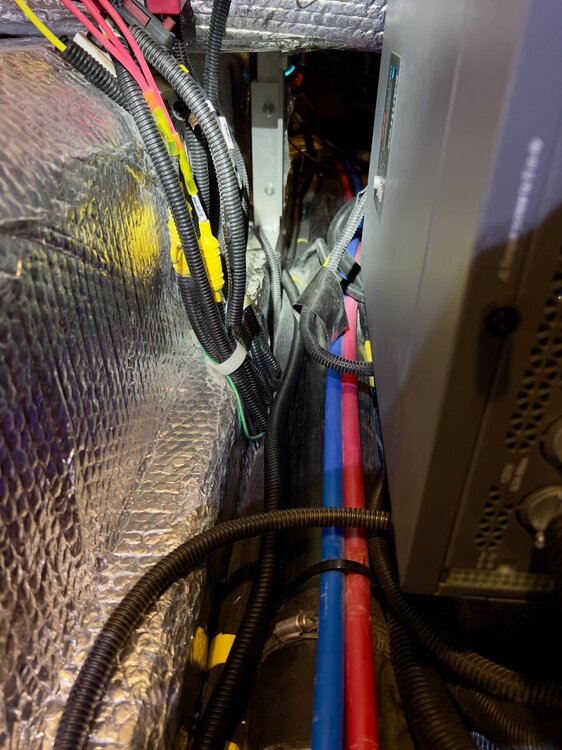
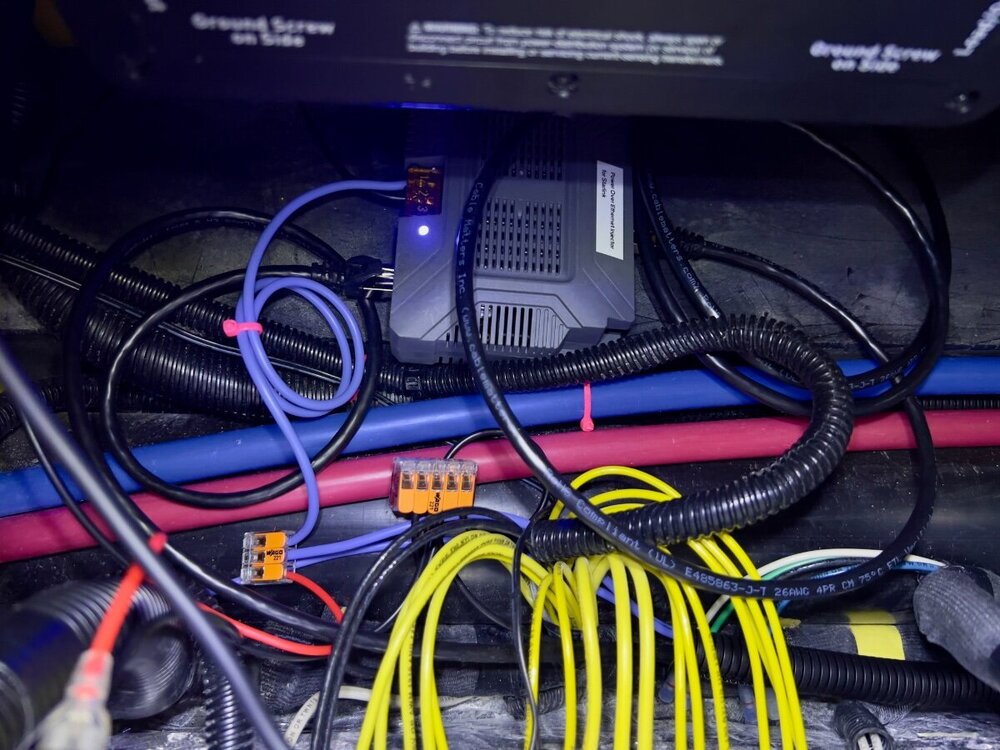
.thumb.jpeg.5c51e10b6df8c7b04557423821e2ca87.jpeg)
forPoEInjector.thumb.jpeg.2d3a22ebf22c78753101dc19af93f47a.jpeg)
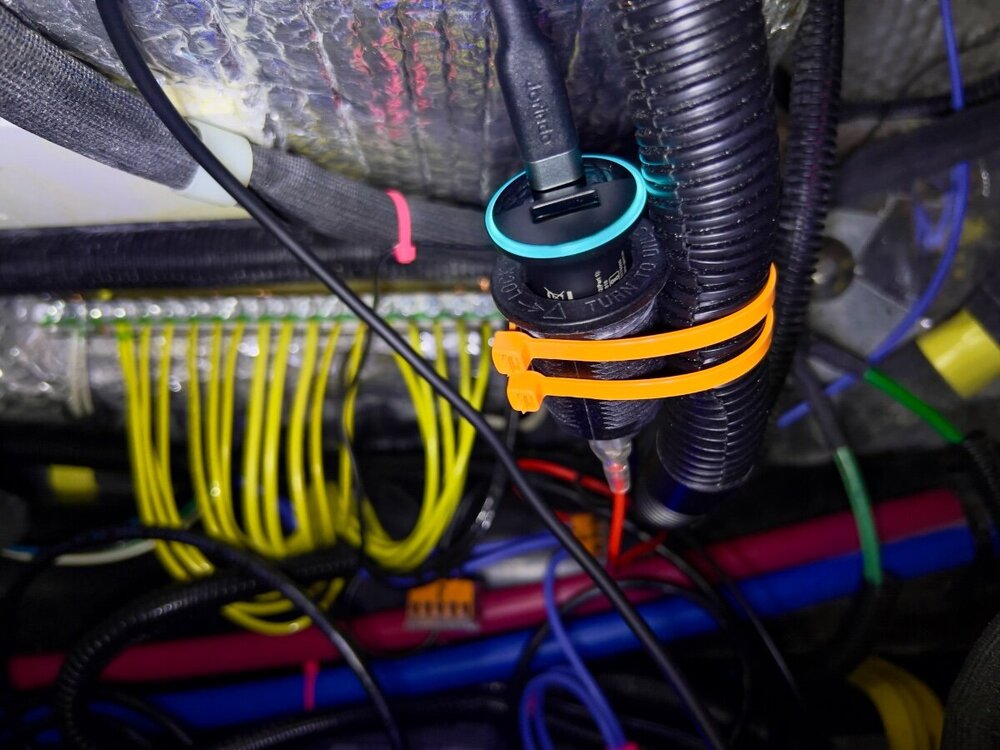
atopProgressiveSurgeProtector.thumb.jpeg.19a73dcde5e0b2f0c1d62e4b93b3337d.jpeg)





.thumb.jpeg.400f99eb6a7703f9d7aa2a8b80da3f7b.jpeg)
.thumb.jpeg.2ef8acc4e4487fe7e453e232307840ae.jpeg)



.thumb.jpeg.75c87a54c4097cc12360f89b752ffee0.jpeg)

